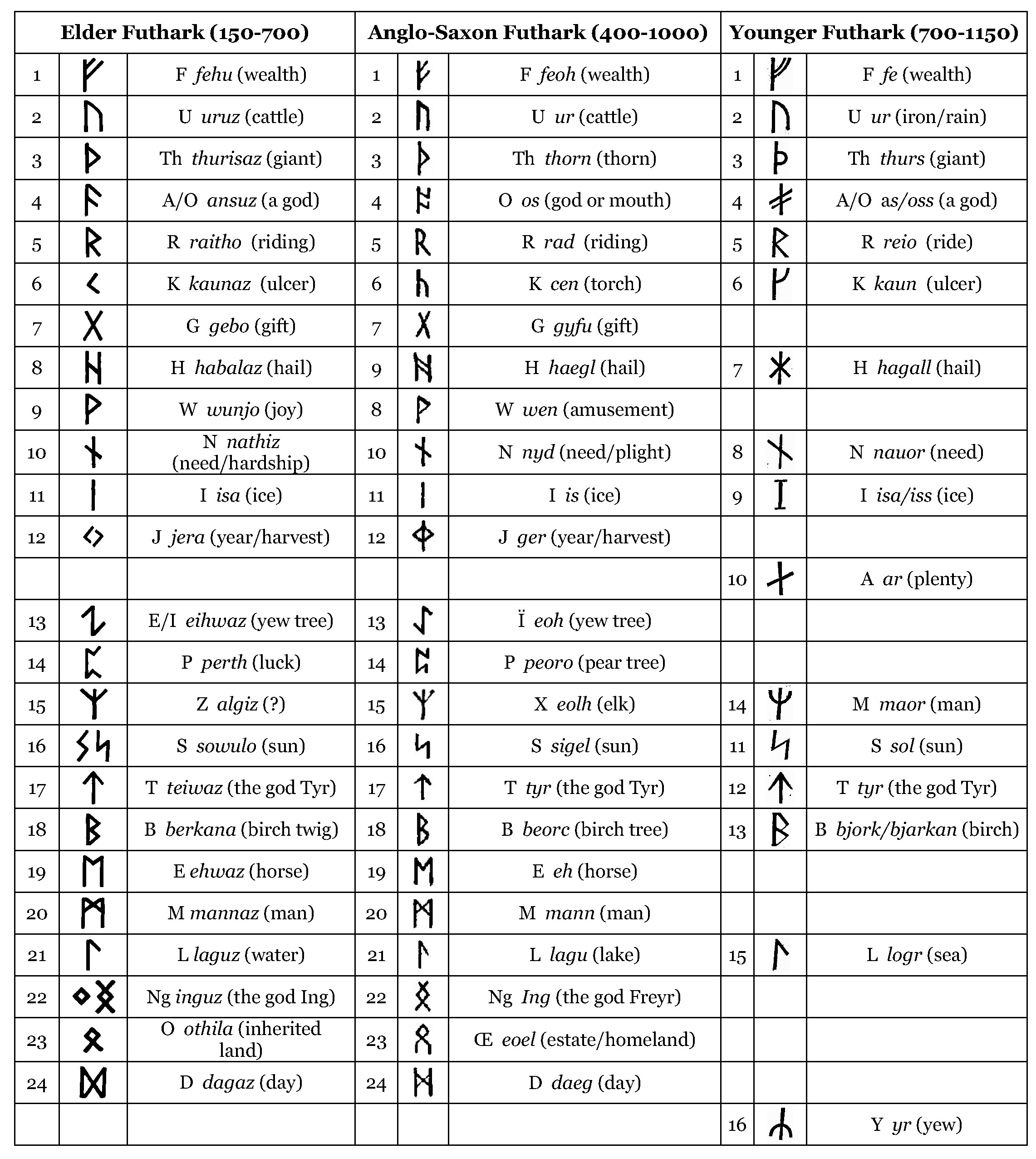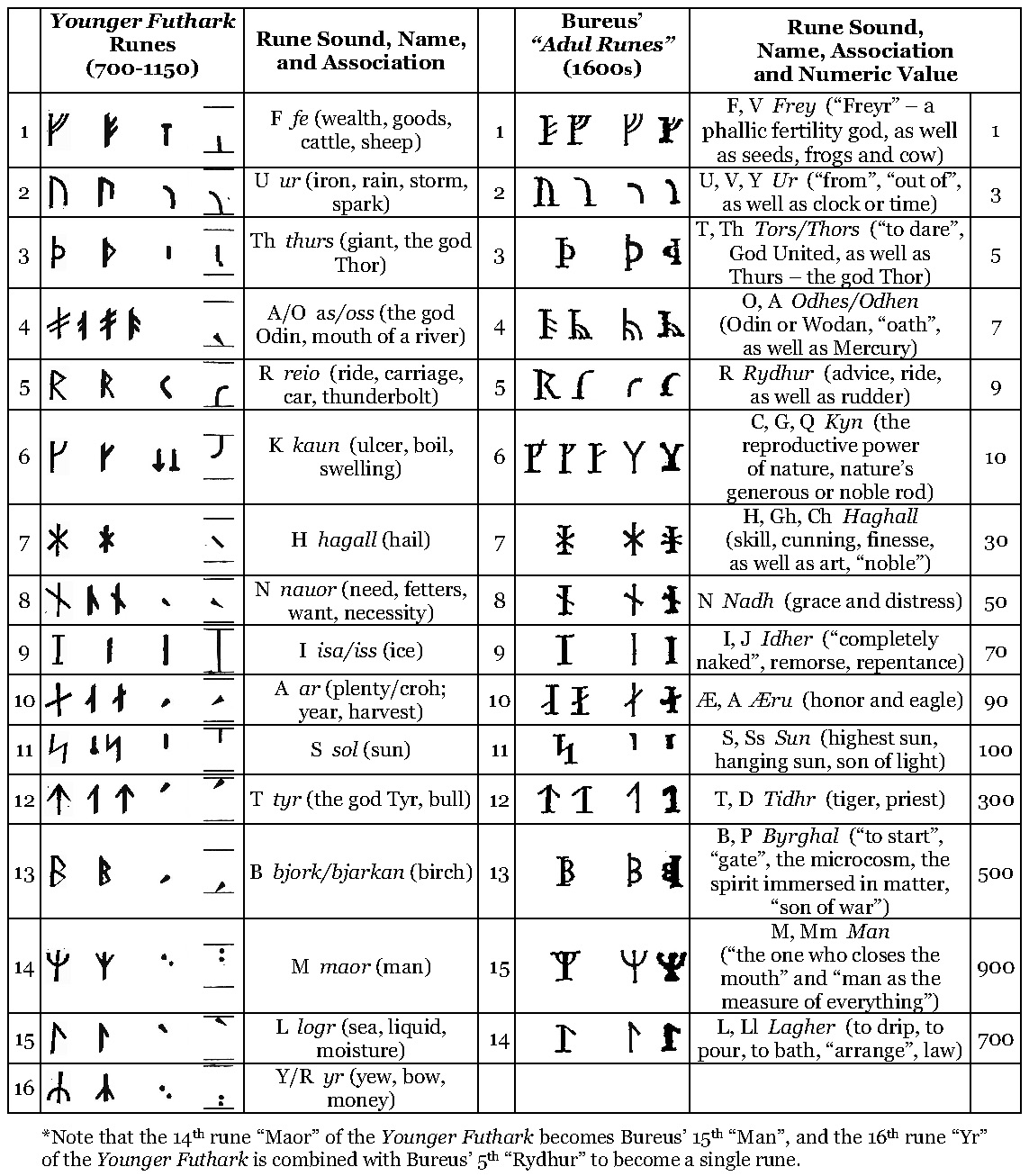The Reemergence of Runic Studies
European Esotericism in the 17th Century
With the expansion of the Roman Catholic Religion during the Middle Ages (which lasted from about the 5th–15th century), the use of any non-Christian spiritual system was frowned upon. Depending on the country and the time period, one could easily be imprisoned or put to death for studying or practicing “Paganism” (other terms used for basically the same classification were ‘hellene’, ‘gentile’, and ‘heathen’). Thus, even in Scandinavia, the study and use of the runes had declined – at least on a public level.
_sm.jpg) However, towards the end of the Protestant Reformation (which lasted from approximately 1517–1648), there was a very interesting esoteric or occult current that began its movement through northern Europe: Rosicrucianism.
However, towards the end of the Protestant Reformation (which lasted from approximately 1517–1648), there was a very interesting esoteric or occult current that began its movement through northern Europe: Rosicrucianism.
Between 1614–1617, three anonymous manifestos were published in German, and later translated into other languages, spreading throughout Europe. These were:
• Fama Fraternitatis RC [“The Famous RC Brotherhood”] (1614),
• Confessio Fraternitatis [“The Confession of the Brotherhood”] (1615), and
• Chymische Hochzeit Christiani Rosencreutz [“Chymical Wedding of Christian Rosicross”] (1617).
In the early 17th century, these manifestos caused excitement throughout Europe by declaring the existence of a secret brotherhood of alchemists and sages who were preparing to transform the arts, sciences, religion, political and intellectual landscape of Europe.
The books also called for others to come forward in support of the brotherhood and ignited a stream of publications sympathetic with the Rosicrucians between 1614 and 1620, amounting to more than 200 texts.
Johannes Bureus and the “Nordic Renaissance”
Right about this same time another book was published (although in Latin, not German), which is much less well known:
c.jpg)
• FaMa e sCanzla reDVX [“The Famous Return of Scanzla”] (1616)
Its author was a Swede named Johan Bure (1568-1652), often Latinized as Johannes Bureus.
A little over 20 years prior, in 1593, Bureus became a civil servant and was appointed as editor of religious texts in Stockholm. He lived in an area that had many runestones, but claims he never really noticed them until just before he moved to Stockholm, when one awakened his curiosity…
 He was captivated by the strange scripts and wanted to learn how to read them. Between 1599-1600 Bureus made an extensive trip throughout Sweden to find more runestones in an effort to document, translate and interpret them. The King even asked him to translate certain stones.
He was captivated by the strange scripts and wanted to learn how to read them. Between 1599-1600 Bureus made an extensive trip throughout Sweden to find more runestones in an effort to document, translate and interpret them. The King even asked him to translate certain stones.
 by Thomas Karlsson.jpg)
In 1604, Bureus was appointed tutor to the young Swedish Prince Gustavus Adolphus (who later became the King of Sweden in 1611). In the 1610s, Bureus was promoted to Royal Librarian. The following year, he wrote a runic ‘ABC’ booklet and wanted to allow other people to understand the language of the runes.
Bureus seemed to have been influenced by other mystical currents of the time: Alchemy, Christian Kabbalah, Magic, etc. According to historians, he studied authors such as: Paracelsus, Pico della Mirandola, Johann Reuchlin, Guillaume Postel, Heinrich Khunrath and others.
Eventually, he became convinced that the runes had an occult side to them (similar to the letter-mysticism and numerology of the Kabbalah). He called his system of Runic Kabbalah “Cabala Upsalica ” and its esoteric aspect ‘adulrunor ‘ which means the “Adul Runes” (or ‘Noble Runes’). Thus, he is often called the first of the modern rune revivalists…
 MS. Fa 21, Royal Library, Stockholm_OCR.jpg) Runic Alphabets and Bureus’ Rune Row (or Set of 15 Runes)
Runic Alphabets and Bureus’ Rune Row (or Set of 15 Runes)
What makes Bureus so interesting for us is his reduction of all the different runes he encountered into a set of just 15. One could say that this set of Runes (often called a “Rune Row”) is a modification of different variants of the Younger Futhark alphabet.
We will see later, that this same set of runes was built upon by Volkisch Runologists (and specifically Guido Von List) who added a few more Runes from the Elder and Anglo-Saxon Futhark .
However, what is important to note here is that Bureus appears to be the Innovator or “Originator” of this Hermetic & Kabbalistic way of looking at the Runes (at least in recent history).
The Younger Futhark is one of 3 main divisions of the Runes as they have been classified by scholars, the others being the Elder Futhark and the Anglo-Saxon Futhark . Runic Alphabets have changed over the years and have their different letters (or ways of writing the same letter) which varied by location, etc.
The Younger Futhark (mainly used in Scandinavia) seems to have developed as a reduction of the Elder and the Anglo-Saxon Futhark :

The basics of Johannes Bureus’ “Adul Rune” system were to work with modified versions of the Younger Futhark runic alphabets (by combining the “Long Branch”, “Short-twig” and the Hälsinge or “Staveless” variants together):

 by Thomas Karlsson.jpg) Bureus’ System of Occult Runology
Bureus’ System of Occult Runology
Bureus’ reduction (and slight reordering) of the different Younger Futhark variants into a single script appears to be the foundation or ground work for later Runologists. One might even say that the ‘Adul Runes’ are the basis of the so-called “Armanen runes” popularized almost 300 years later by Guido Von List and others.
 by Thomas Karlsson.jpg) Part of Bureus’ system was den Liggande Stenen or “the Falling Stone”, a cube with three sides visible. On each of the visible sides, five runes are depicted (in a cross or X shape). In each group, at least 2 runes are illustrated as the mirror (or inverse) of one another.
Part of Bureus’ system was den Liggande Stenen or “the Falling Stone”, a cube with three sides visible. On each of the visible sides, five runes are depicted (in a cross or X shape). In each group, at least 2 runes are illustrated as the mirror (or inverse) of one another.
 MS. Fa 21, Royal Library, Stockholm_OCR.jpg) He arranged these same 15 runes into another cross-symbol which seems to be related to the Kabbalistic Tree of Life, and the Yggdrasil World Tree (see the “Titulus III” image on the right).
He arranged these same 15 runes into another cross-symbol which seems to be related to the Kabbalistic Tree of Life, and the Yggdrasil World Tree (see the “Titulus III” image on the right).
This rune-cross-symbol’s arrangement was supposed to represent a map of the universe and of the human being, as well as of an initiate’s progress of getting closer to Divinity. For Bureus, the initiate’s progression was related to the vertical line of the cross.
In an effort to explain the larger rune-cross-symbol (with the 15 runes), Bureus makes multiple other smaller rune-crosses (with between 4 – 7 runes) in an attempt to highlight the significance of the runes and their interrelationship(s). An example of one of these smaller rune-crosses is below:
 MS. Fa 21, Royal Library, Stockholm_OCR.jpg)
Here we have a translation of half a page from Bureus’ Adul-Runa (1642) book:

Note the same symbol (in the circle above the cube) in the illustration below:
 by Thomas Karlsson.jpg)
In the next class, we’ll look at how, though the particular influences affecting the German-Speaking World over the following centuries, Esotericism and Runology eventually merged together (in the early 1900s) into an environment ripe for exclusivity and prejudice.
Download the Handout for this class:
– = Read the NEXT PART = –